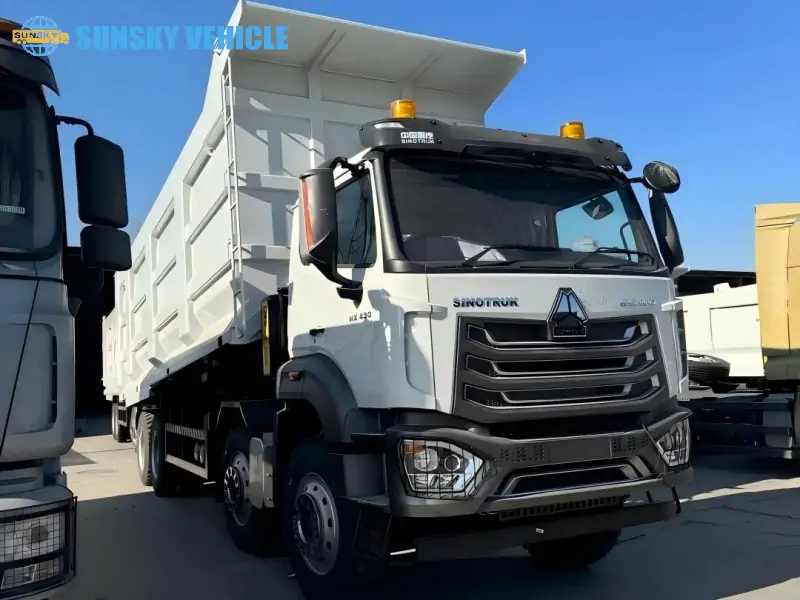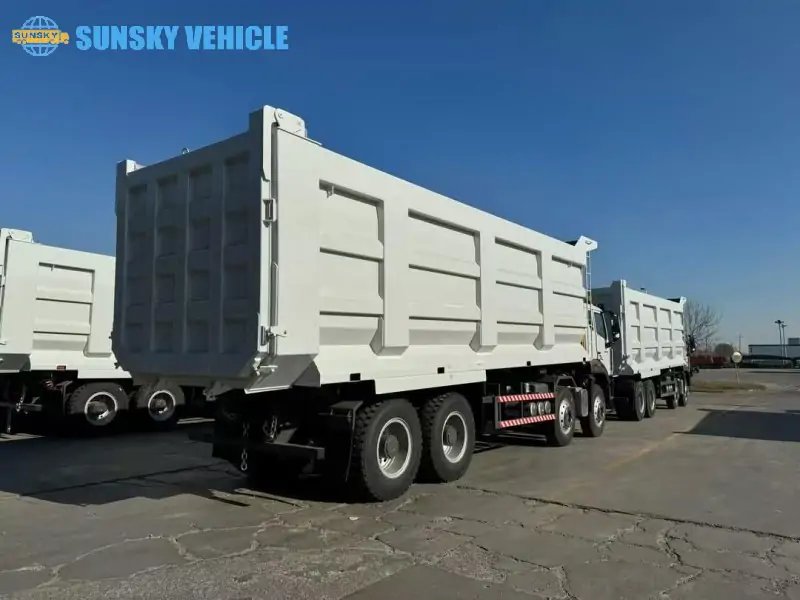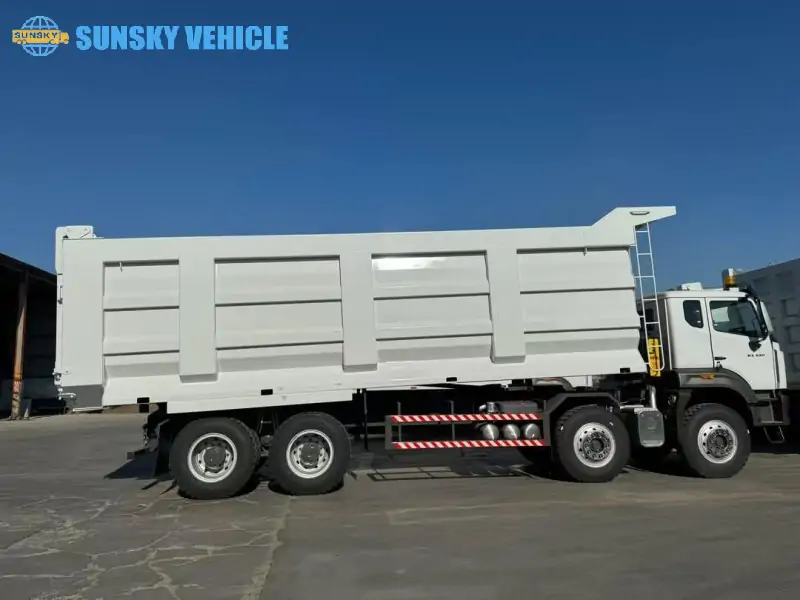Introduction
In construction, mining, landscaping, and large-scale material hauling, dump truck capacity is a key factor affecting cost, efficiency, legal compliance, and safety. Even a few tons difference per load can impact fuel consumption, number of trips, driver labor, and potential fines.
Many fleet owners and operators ask, “How many tons can a dump truck hold?”
The answer depends on truck type, GVWR (gross vehicle weight rating), empty weight, material density, axle configuration, and local legal limits. Misjudging these factors can lead to overloaded vehicles, higher maintenance costs, or violations.
This article will cover:
- How many tons a dump truck carry?
- How to calculate payload based on weight and volume
- Legal and practical limitations
Learn more about dump truck types and applications.
Basic Terms and Key Definitions
1. What is a Dump Truck?
A dump truck is a heavy-duty vehicle used for transporting bulk materials such as sand, gravel, dirt, and construction debris. Dump trucks can have single, tandem, tri-axle, or quad-axle configurations to increase payload and distribute weight efficiently.
2. Types of Tones
- Metric Ton (Tonne / 公吨): 1,000 kg ≈ 2,204.62 lbs
- Short Ton (US Ton / 短吨): 2,000 lbs ≈ 907 kg
- Long Ton (UK Ton / 长吨): 2,240 lbs ≈ 1,016 kg
3. Conversion Between Tons
- 1 Metric Ton = 1.10231 Short Tons = 0.98421 Long Tons
- 1 Short Ton = 0.907 Metric Ton
- 1 Long Ton = 1.016 Metric Ton
Note: Different countries use different units; always confirm the unit before calculation.
Typical Load Capacity of a Dump Truck
1. United States / Canada
- Typical payload: 15–25 US tons
- GVWR: Up to 80,000 lbs (~36.3 t)
- Empty truck weight: 20,000–30,000 lbs
- Recommended safe payload: 15–18 tons
- Special permits can allow heavier loads
2. Other Countries/Regions
| Country | Total Weight | Payload |
|---|---|---|
| EU | 26–32 t | 13–18 t |
| UK | ~26 t | ~13–18 t |
| Australia | 22.5–26 t | 12–16 t |
| China | 24–31 t | 15–18 t |
| India | 25–28 t | 15–20 t |
3. Truck Axle Comparison
| Truck Type | Axles | Payload | Use Case |
|---|---|---|---|
| Single Axle | 1 | 5–7 t | Small projects |
| Tandem Axle | 2 | 10–15 t | Construction |
| Tri-Axle | 3 | 15–25 t | Engineering, sand & gravel |
| Quad Axle | 4 | 25–30+ t | Heavy-duty hauling |
Robust and Durable, Achieve Exceptional Transport
Start your project today and get a high-performance semi-trailer solution tailored specifically to your unique needs.
Payload Calculation Methods and Examples
1. Volume × Density Method
Weight (tons) = Volume (cubic yards) × Material density (tons/yd³)
- Truck bed volume = Length × Width × Height
- Example: 14 ft × 7.5 ft × 4 ft ≈ 15.5 cubic yards
- Gravel density ≈ 1.35 t/yd³ → 15.5 × 1.35 ≈ 22.5 tons
2. Total Weight – Empty Weight Method
Payload = GVWR – Empty Weight
- Example: GVWR 80,000 lbs – Empty 26,000 lbs = 54,000 lbs ≈ 27 US tons
- Legal limits usually 15–18 tons without special permits
3. Axle Load Distribution
- Front axle: 12,000–20,000 lbs
- Rear tandem axles: 17,000–20,000 lbs each
- Total combination: 42,000–54,000 lbs
- Distribute load evenly to avoid axles.
Factors Affecting Dump Truck Capacity
- Truck frame & material – steel vs aluminum, reinforced beams
- Tire rating & pressure – match load rating
- Suspension & axle spacing – spring, air bags, lift axles
- Road & bridge limits – DOT formula, GB1589, EU standards
- Weather & terrain – wet, muddy, slopes
- Loading method—flat, pile, or mountain style
- Safety margin—keep 10–20% extra capacity
Robust and Durable, Achieve Exceptional Transport
Start your project today and get a high-performance semi-trailer solution tailored specifically to your unique needs.
Legal & Regional Considerations
- US & Canada: Typical payload 15–25 t, GVWR 80,000 lbs, overweight permits available
- Europe / UK / Australia: Tri-axle rigid trucks 26–28 t, four-axle 32–38 t
- China / India: 24–31 t depending on truck & local regulations
- Overload risks: fines, vehicle seizure, accidents, insurance denial
- Check local rules via DOT, transport department, industry association, overweight permit system
Loading Optimization & Risk Tips
- Distribute weight evenly to avoid tipping
- Do not exceed truck bed height
- Maintain tire pressure & check tire condition
- Inspect suspension, beams, hinges, and supports regularly
- Use onboard weight monitoring systems
- Common accident prevention: tipping, axle breaks, tire blowouts, material spillage
Conclusion & Recommendations
- Typical dump truck payload: 15–25 tons depending on type and region
- Calculate payload via volume × density or GVWR – empty weight
- Understand legal limits and material density
- Select truck type based on project needs, leave safety margin 10–20%
- Perform calculations and consult manufacturers or professionals for precise data
FAQ
How many tons can a dump truck hold?
15–25 US tons depending on truck type, GVWR, material density, and local limits.
What is the difference between cubic yard and ton for a dump body?
Cubic yard measures volume, and ton measures weight. Weight = volume × material density.
Can a dump truck carry 30 tons legally?
Usually no; it requires an overweight permit or lift-axle modifications.
How to convert cubic yards to tons for sand/gravel?
Weight = Volume × Density. Gravel is ~1.35 t/yd³, Sand ~1.1 t/yd³. Example: 10 yd³ gravel = 13.5 tons.
What is the empty weight of a typical dump truck?
20,000–30,000 lbs (~9–13.6 tons).
How do I maximize payload without violating laws?
Even load distribution, proper tire rating, load monitoring, and following GVWR and axle limits.
What are axle load limits for a dump truck?
Front axle ~12,000–20,000 lbs, rear tandem axles ~17,000–20,000 lbs each, total 42,000–54,000 lbs.
Are there country-specific restrictions for dump truck weights?
Yes. US/Canada: 15–25 t; Europe: 26–28 t; UK: 26 t; Australia: 22.5–28 t; China: 25–31 t.




